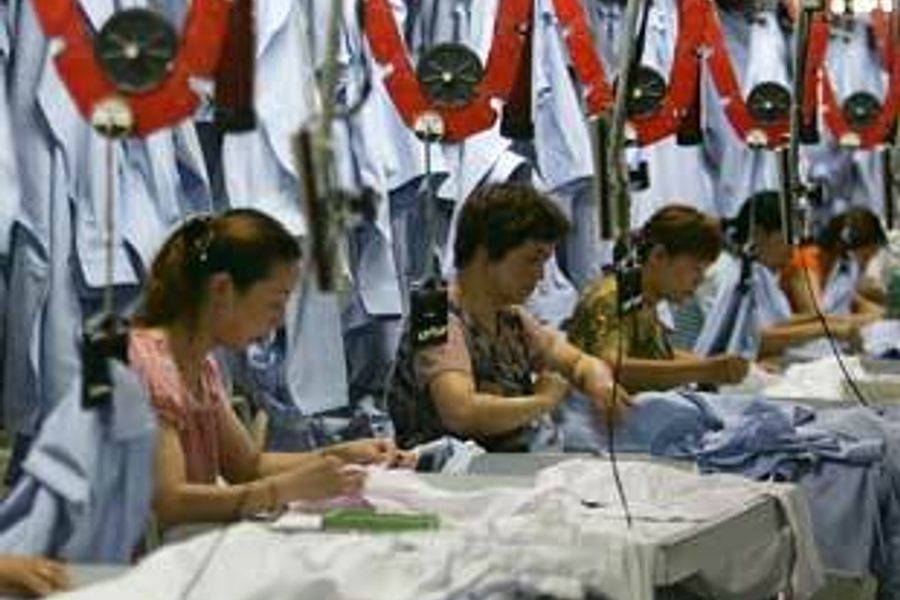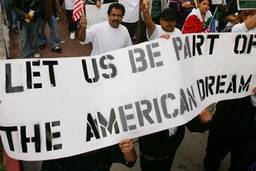New Fair Trade Model Needed
Sweeping changes in the export of textiles have forced a difficult reappraisal among U.S. sweatshop monitors: How best to help workers in a relentless industry?
Mischa Gaus

The expiration of the worldwide quota system that regulated the flow of textiles between the global south and north, now six months old, has created massive job losses across the Americas, Africa and parts of South and Southeast Asia. The quotas restricted the number of textiles and garments each of about 150 countries could import to the United States and the European Union by type. The United Nations Development Program estimated 1 million jobs may be lost as a result.
Following shifts in production to China, Vietnam and India, exports to the United States of some goods from those countries increased by as much as 1,200 percent this year. Sweatshop monitoring groups say other areas handicapped by geography and poor infrastructure, like Swaziland, saw nearly half their factories closed.
The quotas existed for 30 years to protect rich nations’ garment industries from low-wage competition in poor countries. Rich nations gave up quotas a decade ago during World Trade Organization negotiations in return for other favorable rules, and quotas have been phasing out since then. January’s quota termination accelerated the trend in the already cutthroat business that demands annual price cuts from its contracted factories – 2 to 3 percent each year over the last decade, according to a U.S. mill spokesman.
Some estimates say the phase-out could allow apparel corporations to force prices down by as much as 30 percent, making life much worse for apparel workers who still have jobs.
“Factories find a way to meet the price or they don’t,” says Scott Nova, executive director of the factory-monitoring group, Worker Rights Consortium. “One of the ways they’re going to meet it is by screwing their workers. Brands know this and they ultimately bear the moral responsibility for causing it.”
The wrenching changes in the apparel industry vexes groups like the Consortium, which has spent four years focusing on individual factories to help garment workers build independent unions, obtain health benefits, and curb blacklisting, discrimination and physical violence against workers who join unions or attempt to organize them.
But having friends in the north was no immunity. Several of the factories where the Consortium helped secure large gains have closed or idled workers as managers moved production out.
As in the rest of the industry, much of the work fled to China, where independent unions are banned. Undeterred, the Consortium has partnered with Hong Kong-based NGOs that operate in the mainland. With backing from brands that contract with Chinese factories, the group plans to hold labor and safety trainings inside shops – and below the government’s radar. That could nurture independent organizing and, in time, nascent unions.
The crucial question: How long before the Chinese government, which has tolerated some spontaneous worker organizing recently, would see the trainings as a threat?
“Trying to work on labor issues in China is like trying to dance on a nightclub dance floor,” says Clark University sociology professor Bob Ross, who writes on sweatshop issues. “You’ve got just a certain amount of space to wiggle in, and it’s not a lot.”
Ultimately, anti-sweatshop advocates say the kind of factory-by-factory struggle fought thus far and envisioned in China cannot expand enough to counter the unyielding imperatives of capital. Without structural change within the industry – such as year-to-year stability in contracts, ending the ceaseless price cuts demanded by brands, and forcing brands to pay prices that reflect the actual cost of providing workers a decent wage and dignified workplace – lasting and meaningful gains for a significant number of garment workers are impossible.
“We’ve had to jump from factory solidarity campaign to factory solidarity campaign where things arise,” says Allie Robbins, a national organizer with United Students Against Sweatshops. “We’re seeing the need for a new strategy.”
The power of anti-sweatshop activists resides in universities that sell rights to license goods with their logos. Students have forced their universities’ licensees to adopt codes of conduct and disclose factory locations. But since universities only command 1 percent of the apparel market, their influence is limited.
The dynamics of the global apparel industry heighten those limitations. Apparel has always been a chaotic business, where buyers constantly shift work between factories, playing one off another to speed deliveries and squeeze prices. Corporations spread production among hundreds of contractors, leaving monitoring groups narrow leverage when abuses arise.
Brands play a contradictory game, at once proclaiming their social responsibility while demanding factories slash production costs. Nova says the Consortium quickly figured out that factory owners lie to monitoring groups, keeping double books and dictating what workers tell outsiders.
“The reason factory managers feel they have to be dishonest with auditors is because it is impossible to meet the price demands and turn-around demands of their customers and show full respect for the rights of their employees,” Nova says.
With robust monitoring proving unable to sustain workers’ gains, advocates are searching for new models. They may find one in a small factory in El Salvador called Just Garments. After its workers were blacklisted at other factories for organizing four years ago, anti-sweat groups and unions helped the workers establish the first unionized garment factory in the country’s free-trade zone.
Employment and wages at the factory are still low, says Lorraine Clewer, the Consortium’s Latin American field director, because the factory lacks consistent orders and must accept less-complicated, lower-paying work – common in a region hammered by the quotas’ end. Other factories, she says, also refuse to subcontract with the shop because of its unionized workforce.
Help may arrive in October from the Unitarian Universalist Service Committee, a Cambridge, Mass.-based church group, that wants to establish a controlled supply line through a U.S. distributor, guaranteeing a living wage and steady employment for the factory’s 90 workers.
For advocates, the path that could lead to a broad emulation of the Just Garments model is clear: Push the big brands to end contracting volatility and the unrelenting price cuts.
“The fact there has not been a candid discussion in the industry about the relationship between prices and the level of respect for worker rights demonstrates the lack of seriousness of the brands about their codes of conduct,” Nova says. “What this is primarily about for industry is public relations. It’s our job to force them to initiate the discussion.”







